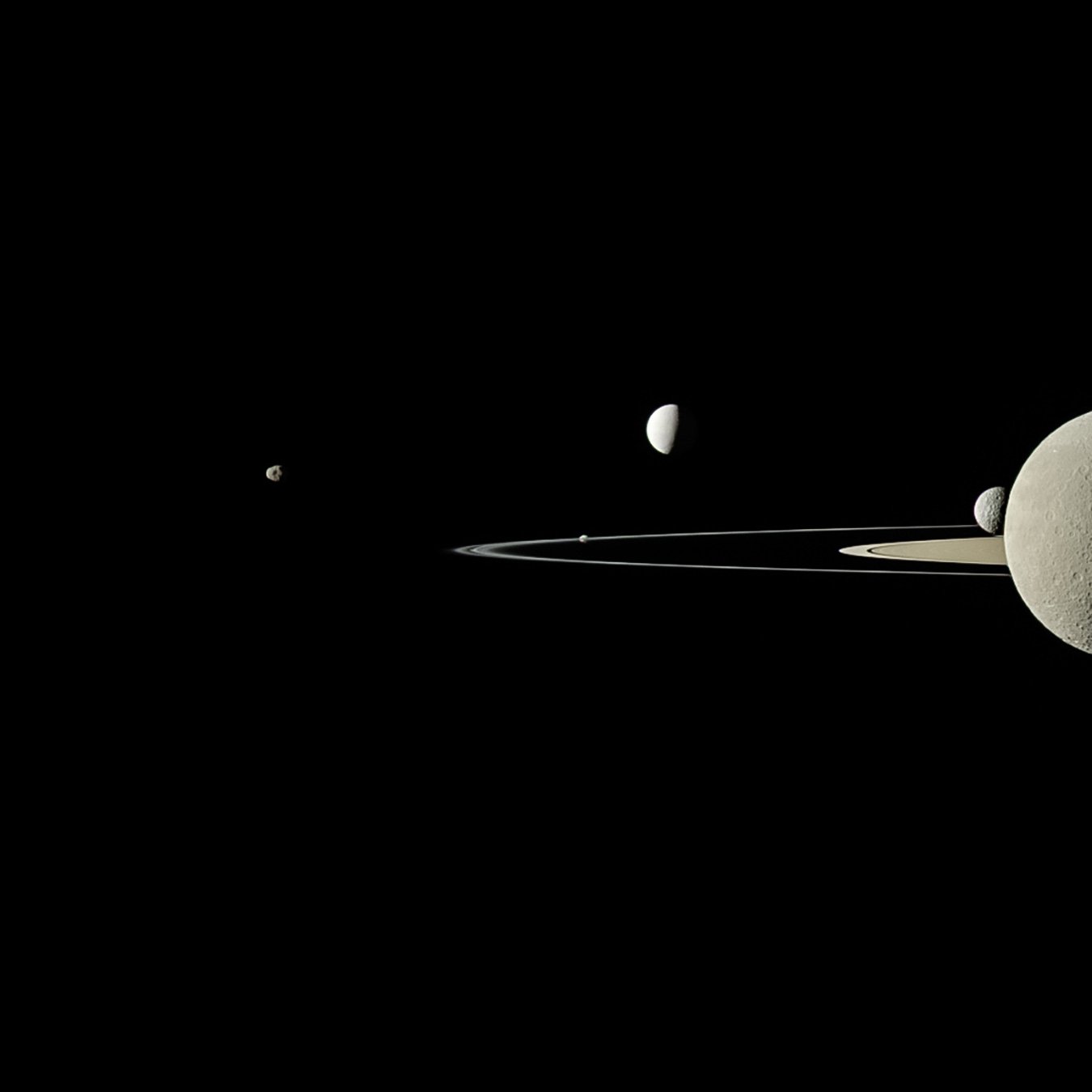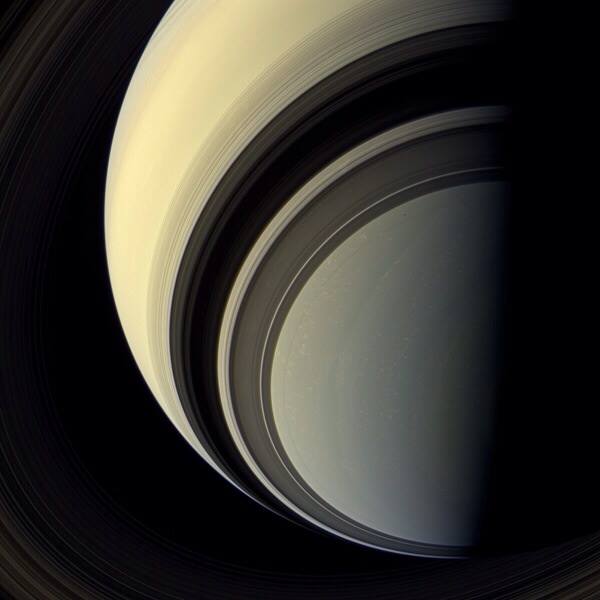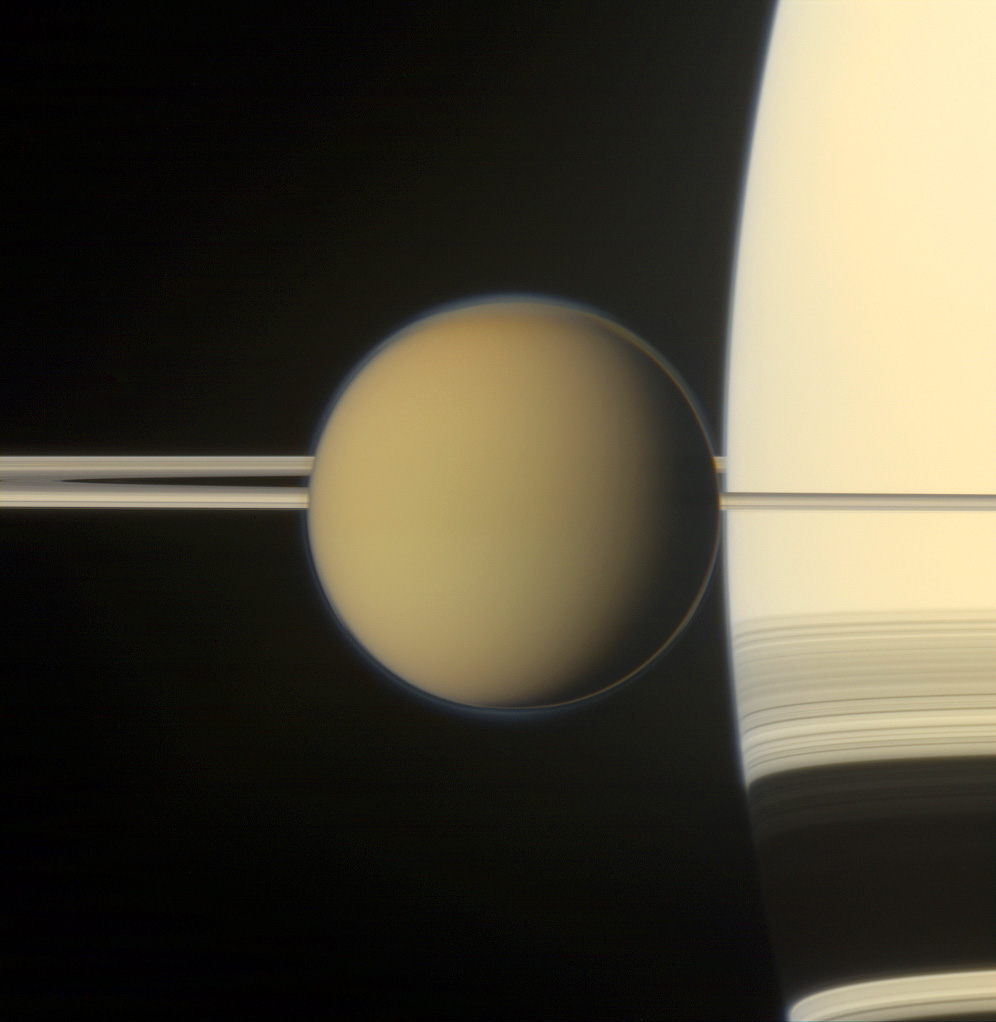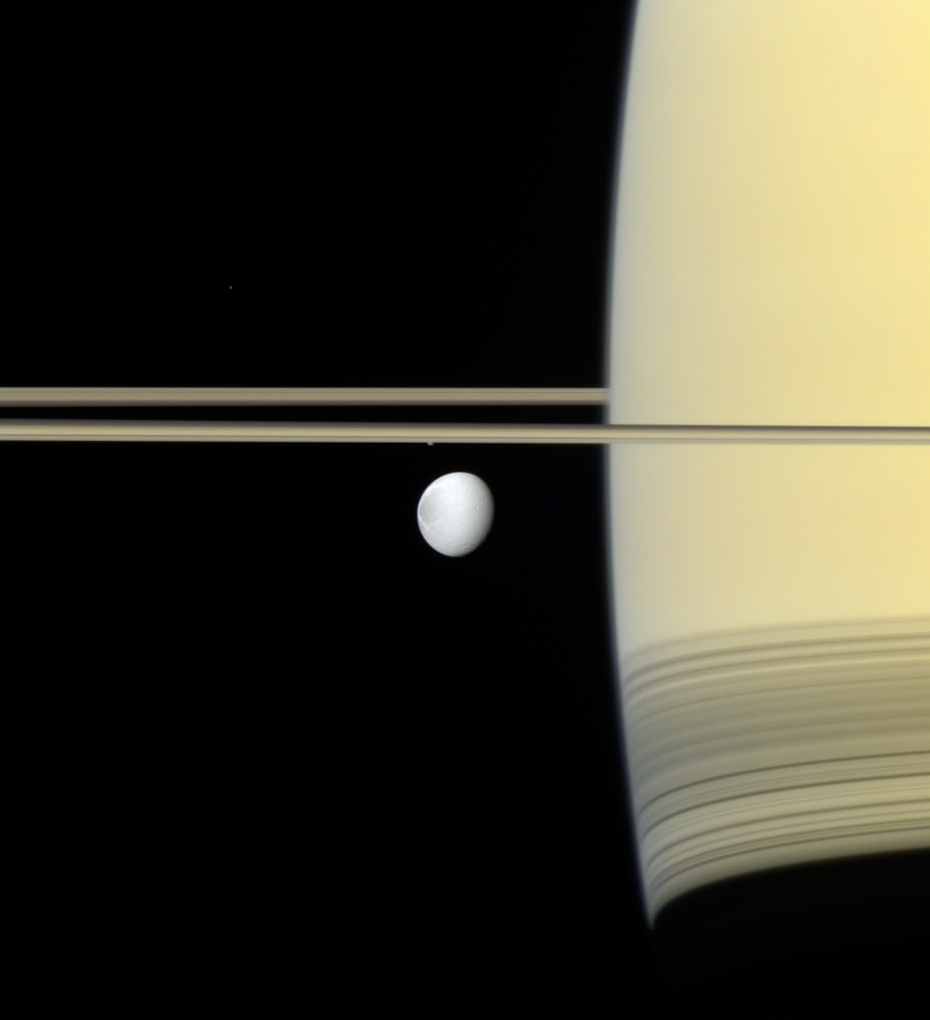“Here's a view of Saturn's moon Prometheus, made from images captured with the narrow-angle camera on Cassini on December 6, 2015. Cassini was about 37,400 km from Prometheus when the images were acquired. Part of the F ring is visible in the background at the top.” — Jason Major
Saturn Family Portrait
From planetary.org: On July 29, 2011, Cassini captured five of Saturn’s moons in a single frame with its narrow-angle camera: Janus, Pandora, Enceladus, Rhea, and Mimas. NASA/JPL-Caltech/Space Science Institute. This is a full-color look at a view that was originally published in September 2011.
The Exotic Tiny Moon Pan
Pan is a moon of the planet Saturn and also happens to have an unusual job “Ring Shepherd”. These are moons which help maintain the many gaps we find within Saturn’s rings. Pan is shown above in it’s natural habitat within the Encke Division of Saturn’s rings. But take a look at what Pan looks like up-close (below).
We have seen this kind of phenomenon at Saturn before, but never quite this dramatic. A small standard potato shaped moon transformed by the accumulation of ring dust and particles into a ravioli shaped moon.
Worth noting that the color shown above is mostly true. The red channel is replaced by infrared and blue channel replaced by ultraviolet — both offer a view that comes close to what you would see with natural light (RGB).
All images were taken by Cassini in March 2017 and processed by Ian Regan.
Saturn’s Rings Slip Into Shade
Saturnati XXXI
 Okay, so it is not totally real. An IR filter was added to the normal RGB files to exaggerate the clouds. Also made the rings appear red. But we couldn’t find a version of this image without the added filter. So — it is about 80% true color. Seen on The Planetary Society image library by Judy Schmidt.
Okay, so it is not totally real. An IR filter was added to the normal RGB files to exaggerate the clouds. Also made the rings appear red. But we couldn’t find a version of this image without the added filter. So — it is about 80% true color. Seen on The Planetary Society image library by Judy Schmidt.
Historic Robotic Spacecraft Poster Survey
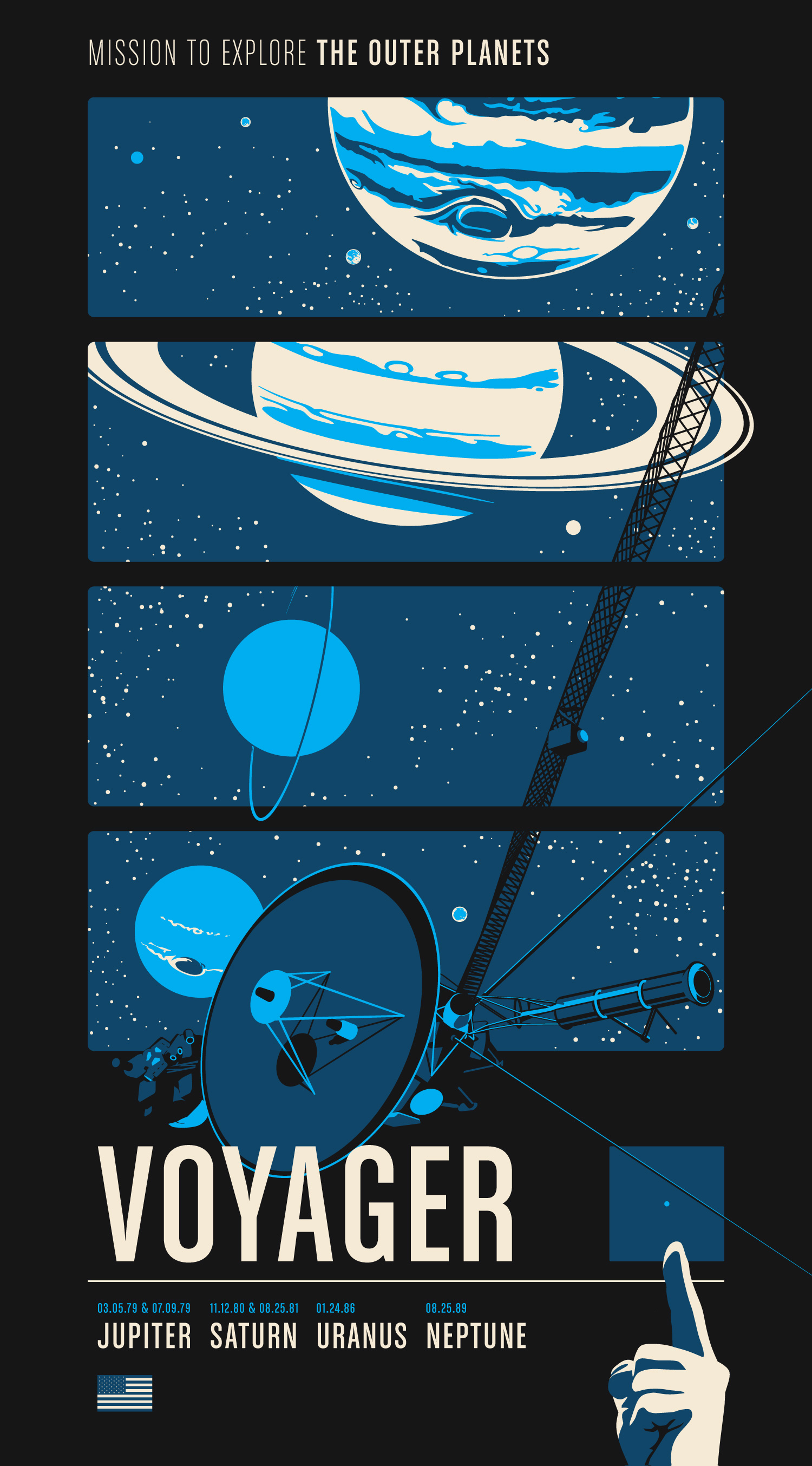 Our new Kickstarter project proposes the creation of three screen-printed posters celebrating the most popular and notable interplanetary robotic space missions in history. Going into this, we knew that poster #1 had to go to the hugely popular Voyager missions (shown above). However, we need your help selecting the themes of posters #2 and #3. So head over to The Planetary Society now to vote on your three favorite missions, but do it by the 19th to have it count for the poster selection. If this goes better than expected we could even wind up designing a fourth or fifth.
Our new Kickstarter project proposes the creation of three screen-printed posters celebrating the most popular and notable interplanetary robotic space missions in history. Going into this, we knew that poster #1 had to go to the hugely popular Voyager missions (shown above). However, we need your help selecting the themes of posters #2 and #3. So head over to The Planetary Society now to vote on your three favorite missions, but do it by the 19th to have it count for the poster selection. If this goes better than expected we could even wind up designing a fourth or fifth.
Discover’s Best of Amateur Imagers
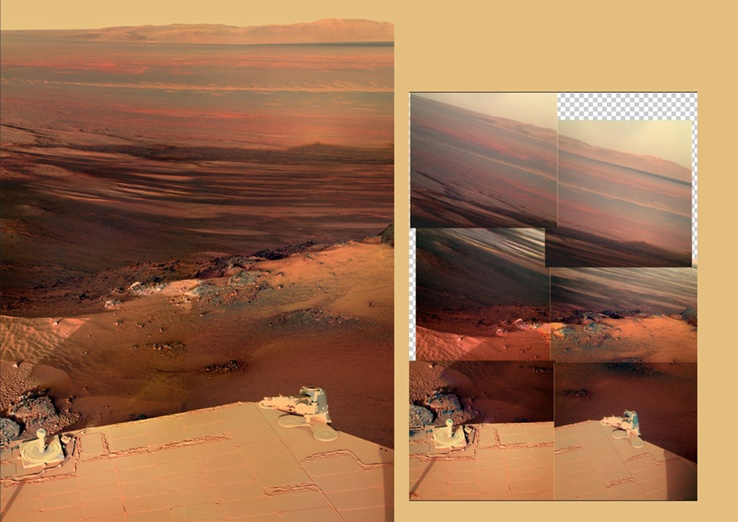 Discover online has an article today about some of the best in amateur space imaging. Many of which have been featured here on Wanderingspace before like Gordan Ugarkovic, Emily Lakdawalla and Bjorn Jonsson to name a few. The last item from Bill Dunford of Riding With Robots is an image that he actually suggested NASA point their HiRise cameras at that location. He suspected they might find something interesting there and they did —flash water movement and evidence of avalanches.
Discover online has an article today about some of the best in amateur space imaging. Many of which have been featured here on Wanderingspace before like Gordan Ugarkovic, Emily Lakdawalla and Bjorn Jonsson to name a few. The last item from Bill Dunford of Riding With Robots is an image that he actually suggested NASA point their HiRise cameras at that location. He suspected they might find something interesting there and they did —flash water movement and evidence of avalanches.
Saturnati XXX
 A fine, fine portrait of Saturn for #30! Created by Ian Regan. There is also an amazing “enhanced” version of the same image going around on Twitter.
A fine, fine portrait of Saturn for #30! Created by Ian Regan. There is also an amazing “enhanced” version of the same image going around on Twitter.
Saturnati XXIX
 Not sure how I missed this one. From a long while back on Gordan Ugarkovic’s Flickr feed.
Not sure how I missed this one. From a long while back on Gordan Ugarkovic’s Flickr feed.
Uranus as Seen from Saturn
 Pretty cool detail caught by two imagers whose work I have been noticing more and more of late. That small blue dot is not Earth, but it is Uranus as it appears from Saturn orbit. Reminds me of this post of our own moon seen with other heavenly bodies within the same frame.
Pretty cool detail caught by two imagers whose work I have been noticing more and more of late. That small blue dot is not Earth, but it is Uranus as it appears from Saturn orbit. Reminds me of this post of our own moon seen with other heavenly bodies within the same frame.
Taken by Cassini on April 11, 2014 and processed by Ian Regan with montage by Val Klavans.
Saturnati XXVII
Saturnati XXVI
 Another from Ian Regan.
Another from Ian Regan.
Enceladus Lost in the Ring Haze
 The tiny but very active moon Enceladus is seen here lost within the E-Ring of Saturn. The moon, as many of us know, is quite active with cryo-volcanic geysers littered throughout the ridges of the “tiger stripes” found mostly in the moon’s southern hemisphere. Since most of the ejecta from Enceladus is jettisoned fast enough to escape the tiny moon’s gravity, most the material winds up orbiting Saturn itself and is therefore helping over a very long period of time to form Saturn’s E-Ring. This at least partly helps solve the question of where Saturn’s massive ring structure originates.
The tiny but very active moon Enceladus is seen here lost within the E-Ring of Saturn. The moon, as many of us know, is quite active with cryo-volcanic geysers littered throughout the ridges of the “tiger stripes” found mostly in the moon’s southern hemisphere. Since most of the ejecta from Enceladus is jettisoned fast enough to escape the tiny moon’s gravity, most the material winds up orbiting Saturn itself and is therefore helping over a very long period of time to form Saturn’s E-Ring. This at least partly helps solve the question of where Saturn’s massive ring structure originates.
Image by Val Klavans.
Around Saturn
Around Saturn from fabio di donato on Vimeo.
In Saturn’s Rings Official Trailer
The long awaited official trailer for “In Saturn’s Rings” has been unleashed. Looking forward to this film for over three years now.
Outer Space Art Film Uses Only Raw Images
Outer Space from Sander van den Berg on Vimeo.
Best of G. Ugarkovic (Last 8 Months)
If you follow this blog on any basis, you might be well aware that a good percentage of the imagery is provided by our good flickr friend Gordan Ugarkovic. Here is a bit of what we missed from him in the last 10 months we were locked out.
Titan at the edge of Saturn taken 2011-05-21. Looks unreal. Like Titan was dropped into the scene using Photoshop. A sin I would never commit. See the lesser “official” NASA version released a few months back here.
Keeping with the theme of moons transiting Saturn. Here is Rhea and tiny Epimetheus doing what they do. Taken in 2010-03-24.
Finally, just to change it up… two moons against Titan, another of Saturn’s moons. Pictured above the Titanian cloud-tops is Dione on the left and Rhea on the right.
Saturn’s Five
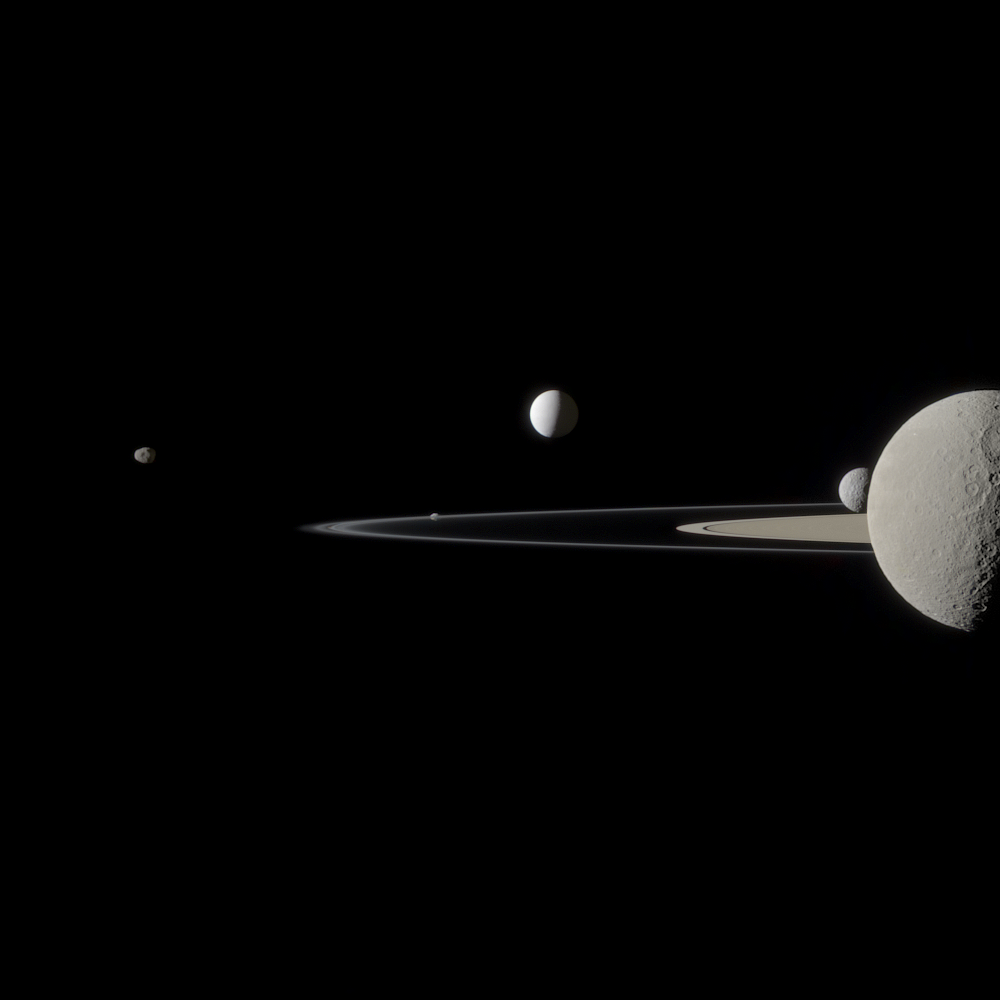 Space enthusiasts seem to really like shots that have more than one body in the same frame. How about five… or six (if you count the rings of Saturn)? Starting left to right that is Janus, Pandora, Enceladus, Mimas and Rhea.
Space enthusiasts seem to really like shots that have more than one body in the same frame. How about five… or six (if you count the rings of Saturn)? Starting left to right that is Janus, Pandora, Enceladus, Mimas and Rhea.
Thanks again to Gordan Ugarkovic.
Dione and Saturn
Saturn Portrait Rings Unlit
 We have had our share of global Saturn portraits, but I do believe this is the first taken where the rings are unlit by the sun. An interesting alternate view provided by Gordan Ugarkovic (as usual).
We have had our share of global Saturn portraits, but I do believe this is the first taken where the rings are unlit by the sun. An interesting alternate view provided by Gordan Ugarkovic (as usual).

